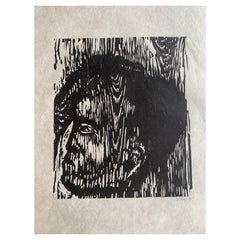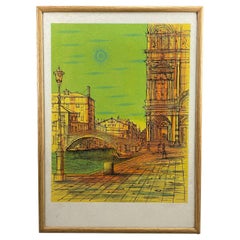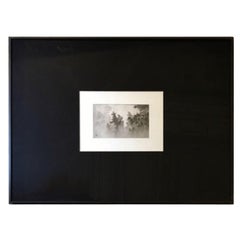Gustav Kluge Furniture
to
1
1
1
1
1
1
1
1
1
1
11,504
3,911
2,408
2,232
Creator: Gustav Kluge
Black and White Woodcut on Japan Paper Signed Gustav Kluge "Supported Head"
By Gustav Kluge
Located in Hamburg, DE
Black and white woodcut on Japan paper signed Gustav Kluge "Supported Head"
Gustav Kluge studied painting at the Hamburg University of Fine A...
Category
1980s Post-Modern Vintage Gustav Kluge Furniture
Materials
Paper
Related Items
Lithography by Jean Carzou on Japanese Handmade Paper
By Jean Carzou
Located in Weesp, NL
Experience the Magic of Venice Through Jean Cartou’s Eyes
Step into the timeless beauty of Venice with this stunning 1973 lithograph by Jean Cartou, crafted on delicate Japanese pap...
Category
1970s French Mid-Century Modern Vintage Gustav Kluge Furniture
Materials
Paper
Early 20th Century Japanese Black and White Paper Print of Antique Screen
Located in Brescia, IT
Early 20th century Japanese black and white paper print of drawings of 18th century Japanese screen.
This black and white paper print ...
Category
Early 20th Century Japanese Art Deco Gustav Kluge Furniture
Materials
Paper
$877 Sale Price
32% Off
H 22.05 in W 29.93 in D 0.99 in
Japanese Woodblock on Paper Print by Katsuyuki Nishijima
Located in Weesp, NL
Beautiful Japanese woodblock print by Katsuyuki Nishijima born in Kyoto in 1945.
Signed, titled and numbered by the artist in pencil.
Nishijima ha...
Category
Late 20th Century Japanese Mid-Century Modern Gustav Kluge Furniture
Materials
Paper
Joan Miro etching aquatint series of 30 on Japanese Paper , 1969
By Joan Miró
Located in La xara, VC
The work in question is part of a series of 30 prints on Japanese paper number with out sign
Provenance Paris around Broder Family publisher .last picture
Explanation:
Series of 3...
Category
1960s Spanish Mid-Century Modern Vintage Gustav Kluge Furniture
Materials
Paper
Ando Hiroshige, Japanese woodblock print on paper. Province of Hyuga.
Located in København, Copenhagen
Ando Hiroshige (1797- 1858), one of the most famous Japanese painters, graphic artists and creators of ukiyo-e.
Japanese woodblock print on Japanese paper.
Province of Hyuga. Landsc...
Category
Early 20th Century Japanese Gustav Kluge Furniture
Materials
Paper
$320
H 11.82 in W 7.49 in D 0.79 in
1920s Style Berlin Street Scene, Black Woodcut on Paper, Framed, 1973
Located in Berlin, DE
"Transport yourself to the vibrant streets of 1920s Berlin with this captivating black woodcut on paper, delicately framed and preserved since its creation in 1973. The artwork encap...
Category
1970s German Bauhaus Vintage Gustav Kluge Furniture
Materials
Glass, Beech, Paint, Paper
$896
H 20.87 in W 20.87 in D 0.79 in
Utagawa Hiroshige Japanese Woodblock on Paper
Located in Astoria, NY
After Utagawa Hiroshige (Japanese, 1797-1858), "Shima Province: Mount Hiyori and Toba Harbor", Woodblock on Paper, 1853, from the "Famous Views of the Sixty-odd Provinces" series, wh...
Category
Mid-20th Century Japonisme Gustav Kluge Furniture
Materials
Wood, Paint, Paper
Francesco Messina Italian Signed Modern Work on Paper
By Francesco Messina
Located in Roma, IT
Beautiful lithograph by the great postwar Italian artist Francesco Messina.
Depicts in a beautiful pose a nude of a woman "Lying Model"
Very rare "Artist's Proof Hors Commerce" with ...
Category
Mid-20th Century Italian Mid-Century Modern Gustav Kluge Furniture
Materials
Glass, Wood, Paper
Print on paper piece of Art signed Moore
By Henry Moore
Located in Miami, FL
Dimensions of the Print : H 17 x W 12.5
the sculptor ‘s drawings are mostly inspired by primitivism style,
« Mother and child » is frequently in the artist’s field of research.
This...
Category
Mid-20th Century British Organic Modern Gustav Kluge Furniture
Materials
Paper
Japanese Woodblock on Paper Print by Katsuyuki Nishijima
Located in Weesp, NL
"Machiya in Marutamachi" Traditional Japanese wooden townhouse that functioned both a residence and busines.
Beautiful Japanese woodblock print by Katsuyuki Nishijima...
Category
1970s Japanese Mid-Century Modern Vintage Gustav Kluge Furniture
Materials
Paper
Helen Hyde Signed Japanese Meiji Era Woodblock Woodcut Print The Hired Baby 1909
By Helen Hyde
Located in Studio City, CA
A beautiful Japanese woodblock print by American artist Helen Hyde (1868 –1919) titled "The Hired Baby" which she created in 1909 while she was living and studying art in Japan.
T...
Category
Early 1900s Japanese Meiji Antique Gustav Kluge Furniture
Materials
Wood, Paper
$795
H 11 in W 12 in D 0.5 in
Fujimaro Kitagawa. Woodcut on Japanese paper. Snowscape with woman and child
Located in København, Copenhagen
Fujimaro Kitagawa (1790-1850) .
Woodcut on Japanese paper.
Snowscape with a woman in traditional clothing carrying a child.
The first half of the 19th c.
Artist's stamp.
In perfect ...
Category
19th Century Japanese Antique Gustav Kluge Furniture
Materials
Paper
$400
H 14.97 in W 10.63 in D 0.79 in
Gustav Kluge furniture for sale on 1stDibs.
Gustav Kluge furniture are available for sale on 1stDibs. These distinctive items are frequently made of paper and are designed with extraordinary care. There are many options to choose from in our collection of Gustav Kluge furniture, although beige editions of this piece are particularly popular. Prices for Gustav Kluge furniture can differ depending upon size, time period and other attributes — on 1stDibs, these items begin at $361 and can go as high as $361, while a piece like these, on average, fetch $361.


